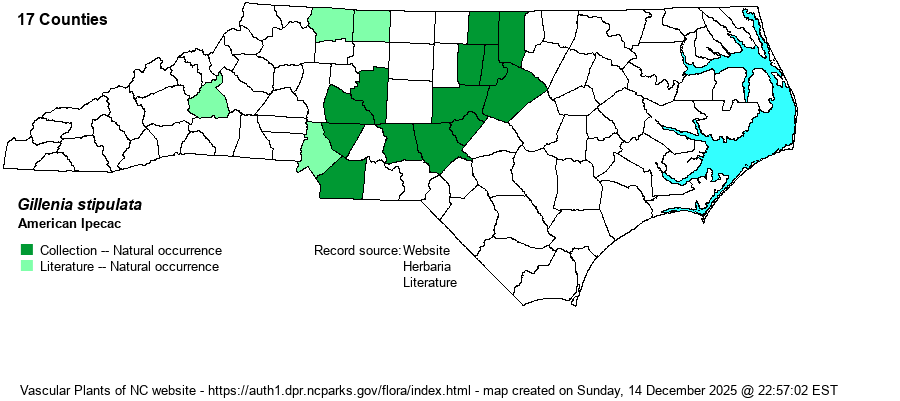| Author | (Muhlenberg ex Willdenow) Nuttall | |
| Distribution | Limited just to the Piedmont, and mainly just in the eastern half. Oddly, there are no specimens from the western half, but the NCNHP has three reports from this part of the province.
This is mainly a Midwestern species, ranging from OH and southeastern KS south to central GA and eastern TX. The population in NC and extreme southern VA is disjunct from the rest of the range, as it is scarce in montane regions.
| |
| Abundance | Rare to locally uncommon in the eastern half of the Piedmont, and very rare in the western half. Though the NCNHP has about 40 records for the species, roughly half are historical, and the species is highly threatened by development in this very populous region of the state. It is a State Threatened species. | |
| Habitat | This species prefers high pH soil, both in dry or somewhat moist forested settings. It grows mainly in upland hardwood forests, such as Basic Oak-Hickory Forest, or in drier portions of Basic Mesic Forest. It also grows in glades, barrens, around rock outcrops, and on roadbanks and wooded edges -- but almost always over mafic rocks in NC. |
| Phenology | Blooms from May to June, and fruits from July to October. | |
| Identification | This is a rather tall herb, growing erectly to about 1.5-2 feet tall. It usually has some branches, and single flowers grow at the ends of the numerous branches. This species has scattered alternate leaves, each being trifoliate, with narrow toothed leaflets about 2-3 inches long and tapered at each end. This species has very large and leafy stipules, such that the leaf looks like it has three narrow fingers and two short "thumbs" at the base. The very similar G. trifoliata has the same three large and narrow leaflets, but the stipules are very small and linear. Each species has similar flowers, each with 5 narrow white petals, and the spread flower is about 1 inch across in this species, and about 1.5 inches across in G. trifoliata. G. stipulata is easily identified just by its leaves, as no similar plant has "5" leaflets, three long ones and two short ones at the base. The fairly large white flowers can also catch your attention, as well. | |
| Taxonomic Comments | The species has also been recently named as Porteranthus stipulatus.
| |
| Other Common Name(s) | Midwestern Indian-physic | |
| State Rank | S2 | |
| Global Rank | G5 | |
| State Status | T | |
| US Status | | |
| USACE-agcp | | |
| USACE-emp | | |

